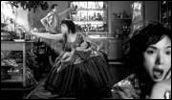Faces of a Fig Tree
- Year
- 2007
- Original title
- Ichijiku no Kao
- Japanese title
- 無花果の顔
- Director
- Cast
- Running time
- 94 minutes
- Published
- 16 March 2008



by Robin Gatto
Premiered at the Berlin Film Festival, Faces of a Fig Tree is Kaori Momoi's first feature film, in which the actress shows an inventive streak likely to either baffle or enthrall. But the seasoned actress, whose diverse range of experiences includes collaborations with the Art Theatre Guild and Akira Kurosawa, as well as Memoirs of a Geisha and Aleksandr Sokurov's The Sun, does not hide the fact that her intention was to rock the stereotypical world of filmmaking in Japan. It is interesting to note, in this regard, that the Ministry of Culture refused to fund the film.
"People either love or hate my film", said actress turned director Kaori Momoi at the Paris premiere of Faces of a Fig Tree, at the Kinotayo film festival. Without going to such extremes, audiences will likely be wondering what to think of the film. The original title Ichijiku no Kao translates roughly as "Faces of Flowerless Fruit", according to the Chinese ideograms. The second title gives a better and fairer hint of the kind of film which Kaori Momoi seems to have wanted to make: as the fig is but a "false fruit" (it is in fact a hybrid, a "flower-fruit"), one may wonder whether Momoi's film is not actually a "false film". Although Momoi has acted her way through movies with such great masters of Japanese cinema, it seems that for her first great directorial effort, after helming episodes of TV series, she wanted to do away with the classic notions of filmmaking and opt for a purely avant-garde approach, more akin to the makings of younger directors like Takashi Miike (with whom she made Sukiyaki Western Django) or comic-turned-director Hitoshi Matsumoto (Dai Nipponjin).
"I have always been the protruding nail, the actress challenging directors about their way of making films. I know the rules but can't help turning them on their head". The vision of Faces of a Fig Tree is a testimony to Momoi's intentions: cinematic grammar and traditional storytelling are discarded in favour of jarring camerawork, with lots of eye-to-camera shots, and surreal narrative vignettes. The story is adapted from a series of short novels written by Momoi in her twenties, which she updated and condensed to obtain a viable screenplay. The central character, played by Momoi herself, is a fairly traditional okasan (a domestic mother-wife) striving to maintain a standard behaviour though faced with daily meaninglessness and ever-shifting social mores: while the husband is increasingly coarse in his demeanor and absent from home, the kids are now more concerned with themselves than with family life.
What seems to be a very classic storytelling pattern along the lines of the haha mono (mother film) or tsuma mono (wife movie) genres, turns in the hands of Momoi into a softly hallucinogenic experience where, unfortunately, the director's efforts to alter the rules of movie-making more often baffle than provoke. Momoi has stated that she wanted to make a film in which storytelling was less important than the actors and the characters. She justified her intentions by saying that very often in her career, she had felt like a mere toy in the hands of all-powerful directors; consequently, her first feature film experience should entail freedom of composition for her players. While the cast can be said to be very good overall - including Momoi herself -, the camerawork does seem, at times, to get in the way of their performances, of their expression - as if Momoi were struggling against her cast to make at all cost an original film which could have been original all the same - and even touching - without the compulsive stylistic endeavor.
Yet, the film does provide a few oddly moving moments, as when Momoi's character, in very long and more static sequence-shot, can be seen reacting to her husband's sudden death (shown sleeping the moment before) with ironic and funny detachment. "You're in the way, dear", she complains as she walks past her hubby's body. Another absurdly funny scene shows her, a few months later, working in a restaurant where a signs says "Talking is forbidden", as in a public library. It does appear nonetheless that such eating places exist in Japan: it is even said that some great noodle masters are so proud of their cooking that they forbid their clients to utter a word!
The artificial nature of the movie is best expressed in the photography which playfully blends studio-like lighting, replete with oranges and blues, with more subdued pictures. The home interiors, a blurring of theatricality and urbanity, were shot on a Nikkatsu studio lot, with colorful sets courtesy of the great Takeo Kimura (who designed countless Seijun Suzuki films, including Gate of Flesh). The fig tree reigns besides Momoi's domestic presence, a symbol of a hybrid life where the difficulty for beauty to flower in the face of modernity does not make existence a fruitless experience. Although the mother-daughter relationship is difficult (and not developed enough in the film), Kaori Momoi's character ends up resting in her daughter's baby's cradle. A beautiful picture in a film that, like the central fig tree, branches out into many promising directions without ever yielding the kind of fruit and savour one might expect.